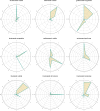Ocular adverse events associated with antibody-drug conjugates: a comprehensive pharmacovigilance analysis
- PMID: 39742259
- PMCID: PMC11685049
- DOI: 10.3389/fimmu.2024.1495137
Ocular adverse events associated with antibody-drug conjugates: a comprehensive pharmacovigilance analysis
Abstract
Introduction: Antibody-drug conjugates (ADCs) are increasingly utilized in patients with solid tumors and hematologic malignancies. However, the adverse ocular toxicity induced by ADCs has not been comprehensively evaluated in real-world clinical settings.
Methods: Data from April 2019 to March 2024 based on the FDA Adverse Event Reporting System (FAERS) were extracted and analyzed. Disproportionality analysis was used to evaluate the association between ADCs and ocular adverse events (AEs). The median time to onset (TTO) of various ADCs was compared.
Results: A comprehensive analysis identified 2,686 ocular AEs associated with ADCs. Among these, Tisotumab vedotin had the most positive signals at the preferred terms (PTs) level, followed by trastuzumab emtansine and enfortumab vedotin. In contrast, gemtuzumab ozogamicin demonstrated minimal ocular toxicity signals. Cluster analysis revealed that ADC-related ocular toxicities predominantly manifested as corneal disorders or ocular neuromuscular disorders. The median onset of ocular toxicity varied considerably, with enfortumab vedotin showing the earliest median onset at 12.5 days.
Conclusions: Our study demonstrates the association between ADCs and ocular AEs based on real-world data, providing valuable guidance for clinicians when prescribing ADCs. And we found some important safety signals that have not been mentioned in the label or previous studies.
Keywords: FAERS; antibody-drug conjugates; ocular adverse events; pharmacovigilance; real-world study.
Copyright © 2024 Chen, He, Huang, Hu and Ma.
Conflict of interest statement
The authors declare that the research was conducted in the absence of any commercial or financial relationships that could be construed as a potential conflict of interest.
Figures




Similar articles
-
Assessing safety concerns of interstitial lung disease associated with antibody-drug conjugates: a real-world pharmacovigilance evaluation of the FDA adverse event reporting system.Int J Clin Pharm. 2024 Jun;46(3):614-622. doi: 10.1007/s11096-023-01673-y. Epub 2023 Dec 15. Int J Clin Pharm. 2024. PMID: 38100054
-
Pharmacovigilance study of the association between peripheral neuropathy and antibody-drug conjugates using the FDA adverse event reporting system.Sci Rep. 2024 Sep 13;14(1):21386. doi: 10.1038/s41598-024-71977-0. Sci Rep. 2024. PMID: 39271716 Free PMC article.
-
Gastrointestinal toxicity of antibody-drug conjugates: a pharmacovigilance study using the FAERS database.BMC Pharmacol Toxicol. 2025 Mar 3;26(1):50. doi: 10.1186/s40360-025-00877-4. BMC Pharmacol Toxicol. 2025. PMID: 40033454 Free PMC article.
-
Interstitial lung disease with antibody-drug conjugates: a real-world pharmacovigilance study based on the FAERS database during the period 2014-2023.Ther Adv Respir Dis. 2024 Jan-Dec;18:17534666241299935. doi: 10.1177/17534666241299935. Ther Adv Respir Dis. 2024. PMID: 39660786 Free PMC article.
-
Antibody-Drug Conjugates: The Toxicities and Adverse Effects That Emergency Physicians Must Know.Ann Emerg Med. 2025 Mar;85(3):214-229. doi: 10.1016/j.annemergmed.2024.10.015. Epub 2024 Dec 4. Ann Emerg Med. 2025. PMID: 39641680 Review.
Cited by
-
Neurological adverse events associated with baclofen: a pharmacovigilance study based on FDA adverse event reporting system.Front Pharmacol. 2025 May 14;16:1569602. doi: 10.3389/fphar.2025.1569602. eCollection 2025. Front Pharmacol. 2025. PMID: 40438599 Free PMC article.
-
Signal mining and risk analysis of tisotumab vedotin adverse events based on the FAERS database.Sci Rep. 2025 Aug 18;15(1):30212. doi: 10.1038/s41598-025-14710-9. Sci Rep. 2025. PMID: 40825814 Free PMC article.
References
MeSH terms
Substances
LinkOut - more resources
Full Text Sources
Miscellaneous

